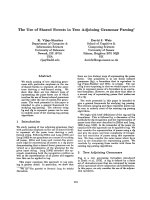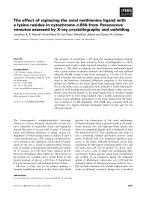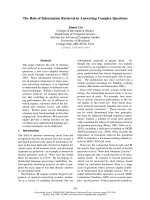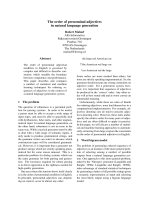báo cáo khoa học: "The effect of crosses made in Tribolium castaneum between lines selected for high and low responsiveness to conditioned medium" pdf
Bạn đang xem bản rút gọn của tài liệu. Xem và tải ngay bản đầy đủ của tài liệu tại đây (231.32 KB, 5 trang )
Note
The
effect
on
egg
laying
of
crosses
made
in
Tribolium
castaneum
between
lines
selected
for
high
and
low
responsiveness
to
conditioned
medium
Batia
LAVIE
U. RITTE
R. MOAV
Department
of
Genetics,
The
Hebrew
University
of
Jerusalem
91904
Jerusalem,
Israel
Summary
Tribolium
castaneum
lines
selected
for
high
(HR)
and low
(LR)
responsiveness
of
egg
production
to
the
conditioning
of
the
medium
were
employed
in
crosses
designed
to
determine
the
direction
of
dominance
for
responsiveness.
In
all
three
populations,
the
cross
between
HR
females
with
LR
males
yielded
responsiveness
values
as
high
or
even
higher
than
the
HR
line,
indicating
dominance
for
high
responsiveness.
The
values
of
responsiveness
encountered
for
the
reciprocal
crosses,
ranging
from
lower
than
the
LR
line
to
higher
than
the
HR
line,
suggest
that
more
than
one
major
gene
is
accounting
for
variation
in
respon-
siveness,
and
that
maternal
effect
may
also
be
involved.
Key
words :
Tribolium
castaneum,
egg
production,
conditioned
medium.
Résumé
Incidence
sur
la
ponte
de Tribolium
castaneum
du
croisement
entre
lignées
sélectionnées
pour
des
sensibilités
de
réponse
forte
et
faible
à
un
milieu
dégradé
Des
lignées
de
Tribolium
castaneum
sélectionnées
sur
la
ponte
pour
une
sensibilité
de
réponse
haute
(HR)
et
basse
(LR)
à
un
milieu
dégradé
ont
été
croisées
pour
étudier
la
dominance
de
cette
caractéristique.
Dans
les
3
populations
étudiées,
le
croisement
entre
femelles
HR
et
mâles
LR
procure
une
sensibilité
de
réponse
supérieure
ou
égale
à
celle
observée
dans
la
lignée
HR
indiquant
par-là,
la
dominance
d’une
forte
sensibilité
de
réponse.
Les
valeurs
de
sensibilité
enregistrées
sur
les
croisements
réciproques
qui
se
situent
(*
) Present
Address :
Institute
of
Evolution,
Haifa
University,
31999
Haifa,
Israel.
en
dessous
de
celle
de
la
lignée
LR
ou
au-dessus
de
HR
laissent
à
penser
que
plus
d’un
gène
majeur
se
trouve
impliqué
dans
le
déterminisme de
la
sensibilité
et
que
des
effets
maternels
peuvent
également
intervenir.
Mots
clés :
Tribolium
castaneum,
ponte,
milieu
dégradé.
Several
studies
have
shown
that
in
addition
to
the
control
of
the
level
of
a
quanti-
tative
trait,
there
may
be
an
independent
control
of
the
responsiveness
of
this
trait
to
the
environment.
So
far,
the
traits
and
organisms
involved
in
these
studies
have
been
growth
rate
in
Schizophyllum
commune
(JINKS
&
C
ONNOLLY
,
1973,
1975 ;
C
ONN
O
LL
Y
&
JINKS,
1975),
final
height
and
flowering
time
in
Nicotiana
rustica
(P
ERKINS
&
JINKS,
1968,
1971,
1973 ;
B
RUMPTON
et
al.,
1977 ;
JINKS
et
al.,
1977 ;
BOUGHEY
&
JINKS,
1978),
and
egg
production
in
Tribolium
castnneum
(LnvtE et
al.,
1978 ;
BOLET et
al.,
1979).
If
the
independent
control
of
the
responsiveness
of
a
trait
is
true,
it
should
be
included
in
selection
programs.
In
many
cases,
for
example,
selection
for
low
respon-
siveness
should
be
more
important
than
selection
for
an
optimal
level
of
the
trait.
A
major
problem
in
the
recognition
of
responsiveness
is
a
knowledge
of
its
genetic
control,
which
should
be
independent
of
the
genetic
control
of
the
trait
itself.
One
solution
to
this
problem
,is
to
use
(3’,
which
is
derived
from
the
analysis
of
genotype
X
environment
interaction.
The
derivation
of (3’
is
as
follows
(M
OAV
&
W
OLH
-
FARTH,
1974) :
in
the
conventional
linear
model,
the
performance
of
the
jt
’’
genotype
on
the
i
th
environment,
g
;j
,
is
partitioned
into
the
average
environmental
effect
(a
;
),
the
average
genetic
effect
(g
f
),
and
a
genotype
X
environment
interaction
(gay) :
Bucio
A
LANIS
(1966)
partitioned
the
interaction
term
into
a
linear
function
of
the
environmental
deviation
(Pja
l)
and
a
residual
independent
component
(8;j),
so
that
the
equation
gets
the
form :
f’&dquo;
. -
M
OAV
&
W
OHLFARTH
(1974)
further
divided
!j
into
sg
j,
which
is
the
correlation
of
the
inter-environment
differences
on
gj
(not
a
true
genetic
interaction),
and
(Y
j
which
is
the
specific
responsiveness
of
genotype j
to
environment
i.
P’
j,
which
can
serve
as
the
unit
of
selection
for
responsiveness,
can
be
calculated
from
the
equation :
In
a
previous
publication
(L
AVIE
et
al.,
1978)
we
presented
results
of
a
selection
program
which
was
based
on
!,(3’,
and
was
carried
out
on
high
and
low
responsiveness
of
egg
production
in
representatives
of
three
wild
populations
of
Tribolium
castaneum
in
Israel
(Jaffa,
Rehovot
and
Beer-Sheva).
In
each
population
two
selection
lines
-
HR
(High
Responsiveness)
and
LR
(Low
Responsiveness)
-
were
established.
The
responsiveness
of
egg
production
was
measured
by
comparing
the
net
fecundity
(number
of
eggs
recovered)
by
virgin
females
in
three
types
of
flour :
fresh,
mildly-
conditioned
and
highly-conditioned.
The
use
of
virgin
females
was
in
line
with
Y
AMADA
(1974),
who
showed
that
the
genetic
correlation
between
the
egg
laying
of
virgin
and
fecund
females
was
0.8,
and
O
ROZCO
&
BELL
(1974),
who
showed
that
in
a
selection
program
for
egg
production,
a
large
amount
of
« error
variance
»
is
removed
if
selection
is
based
on
virgins.
the
three
populations,
statistically
significant
differences
between
the
HR
and
the
LR
lines
were
obtained
after
one
generation
of
selection,
and
these
diffe-
rences
did
hardly
change
in
subsequent
generations.
It
was
concluded
that
(1)
respon-
siveness
for
egg
laying
indeed
has
an
independent
genetic
control,
and
(2)
this
control
is
caused
by
a
small
number
of
genes.
The
present
note
describes
an
additional
aspect
of
this
study,
done
in
an
attempt
to
increase
our
knowledge
of
the
genetic
basis
of
responsiveness.
After
the
sixth
generation
of
selection,
several
females
from
each
selec-
tion
line
were
mated
with
males
of
the
same
line
or
of
the
other
line
of
the
same
population.
Four
types
of
matings
were
thus
created :
LR
X
a LR ; !
LR
X !
HR ;
Y
HR
X
¿ LR;
9 HR
X
d HR.
The
responsiveness
of the
progeny
of
the
various
crosses
(4
types
in
each
wild
population)
was
determined
by
measuring
the
net
fecundity
of
virgin
daughters
in
the
3
types
of
medium,
and
calculating P’
for
each
female.
The
results
of
the
various
crosses
are
given
in
Table
1.
The
purpose
of
the
different
crosses
was
to
find
out
dominance
relationships,
if
they
exist,
between
HR
and
LR.
Although
the
results
of
each
population
should
be
looked
upon
independently
of
the
other
populations,
a
common
feature
of
all
the
populations
was
that
the
response
of
the
daughters
of
the
Y HR
X
LR
cross
was
equal
to
or
higher
than
that
of
the
Y
HR
X
a HR
cross.
This
consistency
was
not
shared
by
the
daughters
of
the
reciprocal
cross
( !
LR
X
d HR),
which
in
one
population
showed
a
higher
value
of W
than
that
of
the
9 HR
X
a HR
cross,
while
in
another
population
it
showed
a
lower
value
than
that
of
the
LR
X
a LR
cross.
Overall
no
definite
conclusion
can
be
obtained
for
the
genetic
control
of
respon-
siveness
of
egg
laying
(a
similar
result
was
obtained
by
B
OLET
et
al.,
1979),
but
the
fact
that
the
response
of
the
HR
X
¿ LR
daughters
was
the
same
as
that
of
the
daughters
of
the
9 HR
X
d HR
cross
may
indicate
that
HR
is
dominant
over
LR
(as
was
found
by
P
ERKINS
&
.IINKS
,
1971
and
C
ONNOLLY
&
JINKS,
1975).
The
diffe-
rence
between
the
populations,
and
the
demonstration
of
dominance
in
only
one
of
the
two
reciprocal
crosses,
suggest
that
responsiveness
is
controlled
in
different
populations
by
different
loci,
that
a
maternal
effect
may
be
involved
in
the
domi-
nance
relationship,
and
that
a
more
complete
understanding
of
the
phenomenon
should
involve
much
larger
samples.
Received
January
17,
1983.
Accepted
September
28,
1983.
References
B
OLET
G.,
C
ALLEGO
A.,
O
ROZCO
F.,
1979.
Déterminisme
génétique
de
la
ponte
de
femelles
vierges
de
Tribolium
castaneum
en
milieu
standard
et
en
milieu
degrade.
Ann.
Génét.
Sel.
Anim.,
11,
251-266.
Bucio
Ar.nNis
L.,
1966.
Environmental
and
genotype-environment
components
of
variability.
I. -
Inbred
lines.
Heredity,
21,
387-397.
B
OUGHEY
H.,
JiNKs
J.L.,
1978.
Joint
selection
for
both
extremes
of
mean
performance
and
of
sensitivity
to
macroenvironmental
variable.
III. -
The
determinants
of
sensitivity.
Heredity,
40,
363-369.
B
RUMPT
ON
R.J.,
BOUG
HEY
H.,
JINKS
J.L.,
1977.
Joint
selection
for
both
extremes
of
mean
performance
and
environmental
sensitivity
to
a
macroenvironmental
variable.
I. -
Family
selection.
Heredity,
38,
219-226.
C
ONNOLLY
V.,
JINKS
J.L.,
1975.
The
genetical
architecture
of
general
and
specific
environ-
mental
sensitivity.
Heredity,
35,
249-250.
Jtrrtcs
J.L.,
C
ONNOLLY
V.,
1973.
Selection
for
specific
and
general
response
to
environmental
differences.
Heredity,
30,
33-40.
JINKS
J.L.,
C
ONNOLLY
V.,
1975.
Determination
of
environmental
sensitivity
of
selection
lines
by
the
selection
environments.
Heredity,
34,
401-406.
Jtrrxs
J.L.,
J
AYASEKARA
N.E.M.,
B
OUGHEY
H.,
1977.
Joint
selection
for
both
extremes
of
mean
performance
and
of
sensitivity
to
a
macroenvironmental
variable.
II. -
Single
seed
descent.
Heredity,
39,
345-355.
L
AVIE
B.,
R
ITTE
U.,
M
OA
v
R.,
1978.
The
genetic
basis
of
egg
lay
response
to
conditioned
medium
in
the
flour
beetle,
Tribolium
castaneum.
I. -
Two-way
selection.
Theor.
Appl.
Genet ,
52,
193-199.
M
OAV
R.,
W
OHLFARTH
G.,
1974.
Magnification
through
competition
of
genetic
differences
in
yield
capacity
in
carp.
Heredity,
33,
181-202.
O
ROZCO
F.,
BELL
A.E.,
1974.
A
genetic
study
of
egg
laying
of
Tribolium
in
optimal
and
stress
environments.
Can.
J.
Genet.
Cytol.,
16,
48-60.
P
ERKINS
J.M.,
Jtrrxs
J.L.,
1968.
Environmental
and
genotype-environmental
components
of
variability.
III. -
Multiple
lines
and
crosses.
Heredity,
23,
339-356.
PE
ttxtrts
J.M.,
JiNKs
J.L.,
1971.
Specificity
of
the
interaction
of
genotypes
with
contrasting
environments.
Heredity,
26,
463-474.
P
ERKINS
J.M.,
Jmncs
J.L.,
1973.
The
assessment
and
specificity
of
environmental
and
geno-
type-environment
components
of
variability.
Heredity,
30,
111-126.
Y
AMADA
Y.,
1974.
Tribolium
as
a
biological
model
in
quantitative
genetics.
Ist
World
Congress
on
Genetics
applied
to
Livestock
Production,
Madrid,
october
7-11,
1974,
1,
439-450,
Garsi,
Madrid.









